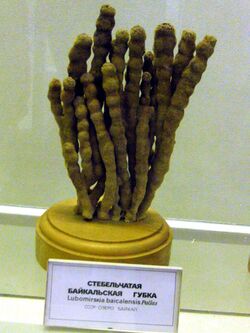Biology:Lubomirskia baicalensis
| Lubomirskia baicalensis | |
|---|---|

| |
| Museum specimen (living are brighter green) | |
| Scientific classification | |
| Kingdom: | |
| Phylum: | Porifera
|
| Class: | Demospongiae
|
| Order: | |
| Family: | |
| Genus: | |
| Species: | L. baicalensis
|
| Binomial name | |
| Lubomirskia baicalensis (Pallas, 1773)
| |
Lubomirskia baicalensis is a freshwater demosponge that is found on hard bottoms at depths between 1 and 120 m (3–394 ft) in Lake Baikal, Russia.[1][2][3] It is commonly called Lake Baikal sponge and it is the most abundant sponge in the lake, but all 14 species in the family Lubomirskiidae are Baikal endemics.[4]
In shallow water L. baicalensis is bark-like, covering stones somewhat like a carpet.[3] From a depth of 3–4 m (10–13 ft) it starts to have branches,[3] and can reach a height of more than 1.2 m (4 ft), which is unusually large for a freshwater sponge.[5] On rocky grounds at depths of 5–12 m (16–39 ft) the branching form is particularly common and may form "forests".[3] This sponge is in mutual symbiosis with a green dinoflagellate, making it green in appearance. Okadaic acid produced by the dinoflagellate assists the sponge to survive when Lake Baikal is iced over in winter, and the water temperature is close to 0 °C (32 °F).[1] It takes 1 year for it to grow 1 cm (0.39 in) taller.[citation needed]
References
- ↑ 1.0 1.1 "Cold stress defense in the freshwater sponge Lubomirskia baicalensis - Role of okadaic acid produced by symbiotic dinoflagellates". FEBS J. (National Center for Biotechnology Information) 274 (1): 23–36. January 2007. doi:10.1111/j.1742-4658.2006.05559.x. PMID 17222175.
- ↑ Kaluzhnaya; Belikov; Schröder; Rothenberger; Zapf; Kaandorp; Borejko; Müller; and Müller (2005). Dynamics of skeleton formation in the Lake Baikal sponge Lubomirskia baicalensis. Part I. Biological and biochemical studies. Naturwissenschaften 92: 128–133.
- ↑ 3.0 3.1 3.2 3.3 Kozhov, M. (1963). Lake Baikal and Its Life. Monographiae Biologicae. 11. pp. 63–67. ISBN 978-94-015-7388-7.
- ↑ Paradina; Kulikova; Suturin; and Saibatalova (2003). The Distribution of Chemical Elements in Sponges of the Family Lubomirskiidae in Lake Baikal. International Symposium - Speciation in Ancient Lakes, SIAL III - Irkutsk 2002. Berliner Paläobiologische Abhandlungen 4: 151-157.
- ↑ Belikov; Kaluzhnaya; Schröder; Müller; and Müller (2007). Lake Baikal endemic sponge Lubomirskia baikalensis: structure and organization of the gene family of silicatein and its role in morphogenesis. Porifera Research: Biodiversity, Innovation and Sustainability, pp. 179-188.
External links
Wikidata ☰ Q1980890 entry

